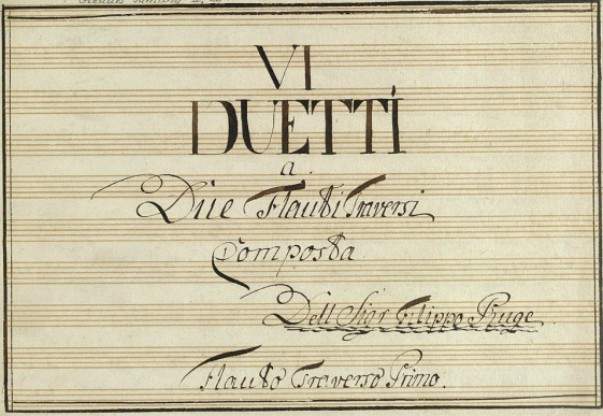
A new Brilliant Classics recording from traverso player, Enrico Casularo and the Flatus Ensemble features charming music by Filippo Ruge. Ruge was an 18th century composer who has been languishing in the wings for too many years, just waiting for his turn to be rediscovered.
An Uncertain Provenance: from Rome to Paris
Like a lot of minor composers, there are many gaps in Filippo Ruge's biography. He was born sometime around 1725, but his provenance is uncertain. Some of the variant spellings of his name seem to indicate German heritage. But in any case, Ruge's designation "Romano," printed in some of his compositions points, if not to his birthplace, then at least to some formative years spent in Rome. Documents from 1744 record membership in the Roman Congregazione Santa Cecilia placing him still in Italy at that time. It's possible that at the start of the 1750s, Ruge may have spent a few years in London, but by 1753, we can say with certainty that Ruge had made his way to Paris.
Concert announcements from March of 1753 advertise Ruge as a soloist with the famous Paris series, the Concert Spirituel. The program included a Romano symphony, along with one of Ruge's own flute concertos.
The Reviews Are In!
The press was good to Ruge. The positive reviews of his performances in the 1750's no doubt attracted the attention of the famous music loving impresario, wealthy lawyer and tax man, La Pouplinière. La Pouplinière often hosted concerts and lavish gatherings in both his Paris mansion and his country house, and when Ruge received an invitation to perform, he joined the ranks of Voltaire, Rameau and Rousseau, and various other musicians, artists and poets whom Pouplinière had befriended.
Ruge composed in a variety of genres: both large scale symphonic works and small scale chamber music. Some of his more intimate music, like the arietta, "Vana di tua bellezza" for two sopranos and two flutes, may have been just the ticket for a concert at the  La Pouplinière residence.
Baroque-to-Classical
When Ruge arrived in Paris, he brought with him lots of new music from fashionable Italian composers, and that proved to be a big draw for Parisian audiences. Ruge not only played this new repertory on his concerts, but together with Venier, a French violinist and music seller, had some of it printed and sold in France under the title Six New Sinfonias by Various Italian Composers. Published in 1757, the set included works by Conforti, Crespi, Galuppi, Jommelli, Latilla, and Mazzoni. Stylistically, Ruge's own symphonies are in the same baroque-to-classical transitional vein as his fellow Italian pre-classical composers. One of Ruge's more famous symphonies that garnered praise from the Concert Spiritual audiences, was his very pictorial 1760 work "La Tempête suivie du calme"or The storm followed by the calm.
Sometime after 1761, Ruge left Paris. To where, or for what, we can't be certain. There's a possibility that for his next gig, Ruge entered into the service of the Marquis de Seignelay: a manuscript collection discovered near the ruins of the Marquis' château contains dozens of Ruge's works and includes a thematic catalogue copied in Ruge's handwriting.
Last Known Compositions
Ruge's last known composition-a set of duets for two flutes, mandolins, or violins-was printed in 1767. After that, the trail of Ruge's life goes cold, and nothing more of the composer is known.
Enrico Casularo and the Flatus Ensemble
There is a sense of immediacy and spontaneity in this recording of Ruge's music by Enrico Casularo and the Flatus Ensemble. Early music fans can be grateful for this recording that brings Ruge's music to the fore.









